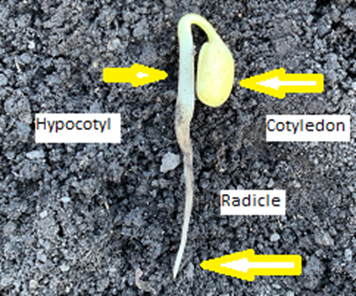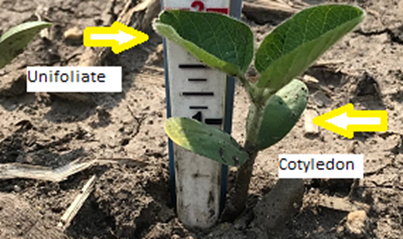Soybean Germination and Early Growth Refresher
BY Dairyland Seed Agronomy Team
Soybeans, much like corn, need to imbibe (take in) water for the germination process to take place. The difference is that soybeans need to take in 50 percent of its weight in water to start this process compared to 30 percent for corn. Since soybeans are about two-thirds the weight of corn, the actual amount of water needed to germinate is very similar.
- Germination is impacted by both moisture and temperature.
- Germination is driven by hormonal systems within the seed. (This process is not well understood, but is being studied.)
- Once germination starts, the Cotyledons (the two halves of the soybean seed also known as the seed leaves) begin to swell. The Radicle, or Primary Root emerges from the seed and Gravitropism or Geotropism (cells within the plant responding to Gravity) take over and the Radicle starts to grow down.
- As cell division continues, the Radicle lengthens. As this is taking place, the Hypocotyl (which is the small section of the stem between the Cotyledon and the Radicle) begins to stretch out and grow toward the soil surface.

- As the Hypocotyl elongates, the Cotyledons are oriented downward and are, in effect, “pulled” upward by elongating Hypocotyl. (Think of a pebble in a sling shot.)
- Lateral roots begin growing from the Radicle shortly before the Hypocotyl pulls the Cotyledons through the soil surface.
- It takes approximately 100-125 Growing Degree Units (GDUs) after planting for the neck, or curved portion of the Hypocotyl above the Cotyledons, to emerge from the soil surface. As it continues its growth upward, the Cotyledons are pulled through the soil surface.
- Once the Cotyledons emerge above the soil line, this is known as the VE stage, or emergence stage, they stretch up, open up and enlarge.
- Shortly after the Cotyledons emerge from the stem, the Hypocotyl will cease to grow but the Epicotyl (stem and subsequent leaves) continues to grow from a point above the Cotyledons.
- As the Epicotyl grows, the Unifoliate leaves emerge, one on each side of the stem. We are now in the VC stage. This is the last node with two leaves. All subsequent nodes will have Trifoliate or three leaves.

- As the stem continues to grow, the first Trifoliate emerges. We are now at the V1 growth stage.

Brian Weller
Western Region
507.456.3034

Rod Moran
Western Region
507.456.3034

Dan Ritter
Central Region
219.863.0583

Branden Furseth
Northern Region
608.513.4265

Mark Gibson
Eastern Region
260.330.8968

Amanda Goffnett
Eastern Region
989.400.3793

Ryan Mueller
Eastern Region
989.400.3793
